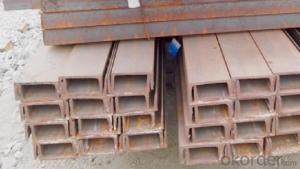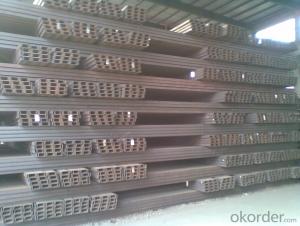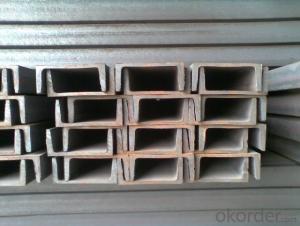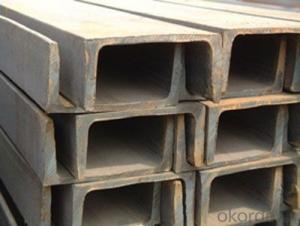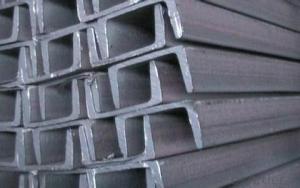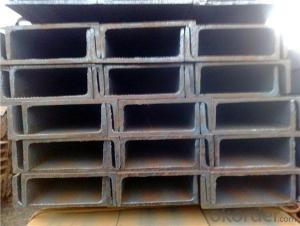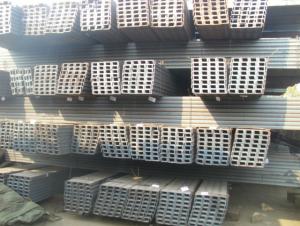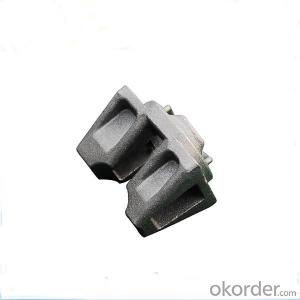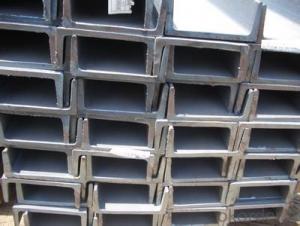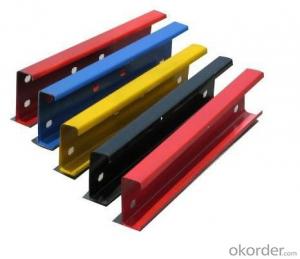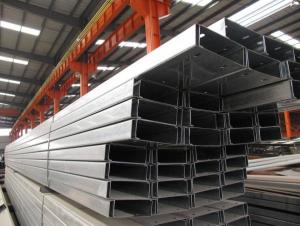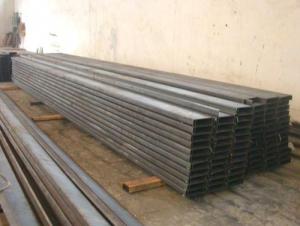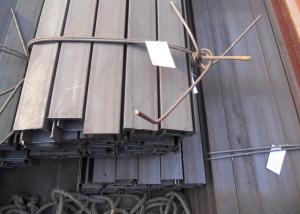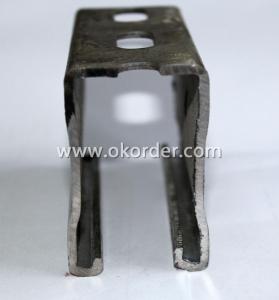Galvanized U Channel Steel Module of Q195-Q345,A36,SS400
- Loading Port:
- Tianjin
- Payment Terms:
- TT OR LC
- Min Order Qty:
- 2000 PCS
- Supply Capability:
- 38000 PCS/month
OKorder Service Pledge
Quality Product, Order Online Tracking, Timely Delivery
OKorder Financial Service
Credit Rating, Credit Services, Credit Purchasing
You Might Also Like
Galvanized Channel Steel Module of Q195-Q345,A36,SS400 Details
| Standard: | AISI,ASTM,BS,DIN,GB,JIS,JIS/ASTM/GB/BS | Dimensions: | 50*37*4.5-400*104*14.5 | Grade: | Q195-Q345 |
| Place of Origin: | China (Mainland) | Brand Name: | Centrue | Model Number: | #5-#40c |
| Shape: | U Channel | Application: | Building Structure etc.,Building Structure | Perforated Or Not: | Not Perforated |
| Length: | 3-12m | Thickness: | 4.5-14.5mm | Certification: | ISO9001 |
| Surface Treatment: | Galvanized/Oiled/Painted | Zinc: | 60um-80um |
Packaging & Delivery
| Packaging Detail: | To be packed in bundles wrapped with steel strip(or as customers requirements) |
| Delivery Detail: | 7-14 days |
Galvanized Channel Steel Module of Q195-Q345,A36,SS400 Specifications
1.Material grade:Q195-235,Q235B,Q345
2.Standard:GB/ASTM/JIS/BS
3.Specification:#5-#40c
4.Delivery time:7-14days (according to the volume of your order)
5.Package :To be packed in bundles wrapped with steel strip(or as customers requirements)
6.Certification:ISO9001
Galvanized Channel Steel Module of Q195-Q345,A36,SS400 Pictures
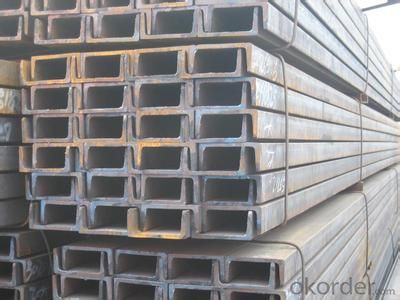

- Q: What are the different methods for designing steel channels for high wind loads?
- There are several methods for designing steel channels to withstand high wind loads. Some of the commonly used methods include: 1. Load and Resistance Factor Design (LRFD): This method uses a combination of load factors and resistance factors to determine the required strength of the steel channels. The loads are calculated based on the wind speed and the dimensions of the building, while the resistance factors are based on the material properties and safety factors. 2. Allowable Stress Design (ASD): In this method, the wind loads are converted into equivalent static loads and compared to the allowable stresses of the steel channels. The allowable stresses are determined by considering factors such as material properties, safety factors, and load combinations. 3. Wind Tunnel Testing: Wind tunnel testing involves constructing a scaled-down model of the building and subjecting it to simulated wind conditions. This allows engineers to analyze the airflow patterns and measure the forces acting on the steel channels. The data obtained from wind tunnel testing can be used to refine the design and optimize the steel channel dimensions. 4. Finite Element Analysis (FEA): FEA is a numerical method that allows engineers to simulate the behavior of steel channels under different wind loads. By dividing the structure into small elements and applying appropriate boundary conditions, FEA can accurately calculate the stresses, deformations, and displacements in the steel channels. This enables engineers to optimize the design and identify areas of high stress concentration that may require reinforcement. 5. Prescriptive Design Codes: Many countries have specific design codes and standards that provide guidelines for designing steel channels for high wind loads. These codes outline the minimum requirements for factors such as channel dimensions, material properties, connections, and fasteners. Following these codes ensures that the steel channels are designed to withstand the expected wind loads. It is important to note that the choice of design method may vary depending on factors such as the complexity of the structure, the available resources, and the specific requirements of the project. Consulting with a structural engineer experienced in designing for high wind loads is recommended to ensure a safe and efficient design.
- Q: Can steel channels be used for marine applications?
- Steel channels are indeed suitable for marine applications. They serve as versatile structural components widely utilized in shipbuilding and other marine-related industries. With their exceptional strength and durability, they prove to be ideal for various marine uses, including ship hulls, decks, bulkheads, and frames. By applying suitable coatings and treatments, the corrosion resistance of steel channels can be enhanced, allowing them to withstand the harsh marine environments. Moreover, steel channels can be effortlessly fabricated and welded to meet specific design specifications, making them the preferred option in marine construction.
- Q: What are the different types of supports used for steel channels?
- Steel channels can be supported using various types of supports, depending on the specific application and load requirements. Some commonly used supports for steel channels include the following: 1. Channel brackets: These brackets are in the shape of an L and are attached to the channel, then secured to a wall or other structure. They ensure the steel channel remains stable and can withstand the intended load. 2. Beam clamps: Beam clamps are utilized to connect steel channels to beams or other structural members. They typically have a threaded bolt that can be tightened to firmly hold the channel in place. 3. U-bolts: U-bolts are curved bolts shaped like a "U" and are employed to secure steel channels to pipes or other round objects. They offer a secure and adjustable connection, allowing for easy installation and adjustment of the channel. 4. Pipe hangers: When steel channels are suspended from above, pipe hangers are used to provide support. These hangers typically consist of a metal strap or clamp that wraps around the channel and then attaches to a ceiling or overhead structure. 5. Strut systems: Strut systems are a versatile and widely used support for steel channels. They consist of metal channels, brackets, and accessories that can be assembled to create a customized support system. Strut systems allow for easy adjustment and have excellent load-bearing capacity. These examples illustrate the variety of supports available for steel channels. The choice of support depends on factors such as the specific application, load requirements, and installation preferences. It is advisable to consult with a structural engineer or industry professional to determine the most suitable support system for a given project.
- Q: What are the different applications of steel channels in the automotive industry?
- Steel channels are widely used in the automotive industry due to their various applications and benefits. Here are some of the different applications of steel channels in the automotive industry: 1. Structural Support: Steel channels are commonly used for structural support in automobile frames, chassis, and body panels. They provide strength and rigidity to support the weight of the vehicle and absorb impact forces during collisions. 2. Reinforcement: Steel channels are used to reinforce critical areas of the vehicle, such as door frames, pillars, and roof rails. They enhance the structural integrity and safety of the vehicle, especially in the event of a crash. 3. Suspension Components: Steel channels are utilized in the manufacturing of suspension components like control arms, sway bars, and trailing arms. These components provide stability, control, and smooth ride quality by connecting the wheels to the chassis. 4. Bumper Reinforcements: Steel channels are incorporated into the design of bumper reinforcements to enhance impact resistance and protect both the vehicle and occupants in case of a collision. They distribute and absorb energy during an impact, minimizing damage. 5. Exhaust Systems: Steel channels are utilized in exhaust systems to create the necessary channeling for the exhaust gases to exit the vehicle. These channels are designed to withstand heat, vibrations, and corrosion caused by the exhaust gases. 6. Seat Frames: Steel channels are commonly used in the construction of seat frames, providing strength and durability. They ensure the seats remain secure and stable, offering comfort and safety to the occupants. 7. Roll Cages: Steel channels are employed in the fabrication of roll cages, which are critical safety features in racing vehicles. Roll cages provide protection to the driver in the event of a rollover or crash, preventing the roof from collapsing. In summary, steel channels play a crucial role in the automotive industry, contributing to the strength, safety, and performance of vehicles. Their applications range from structural support and reinforcement to suspension components, bumper reinforcements, exhaust systems, seat frames, and roll cages.
- Q: Do steel channels have any specific vibration damping properties?
- Steel channels do have some inherent vibration damping properties, although they may not be as effective as other materials specifically designed for vibration damping. Steel channels, due to their solid and rigid structure, can help absorb and dissipate vibration energy to some extent. This is because steel has a relatively high density, which allows it to absorb and distribute vibration energy more effectively than lighter materials. Additionally, the shape and geometry of steel channels can also contribute to their vibration damping properties. The design of the channel, such as its cross-sectional shape and dimensions, can affect its ability to dampen vibrations. However, it is important to note that steel channels may not be as efficient in vibration damping as materials specifically engineered for this purpose, such as elastomers or composite materials. These materials often have properties that are specifically tailored to dissipate vibrations, offering superior damping characteristics compared to steel channels. Therefore, while steel channels do possess some inherent vibration damping properties, they may not be the most effective choice for applications where significant vibration damping is required.
- Q: What are the corrosion resistance properties of steel channels?
- Steel channels have excellent corrosion resistance properties, making them highly suitable for various applications. The corrosion resistance of steel channels is primarily due to the presence of a protective oxide layer on their surface. This oxide layer forms naturally when steel is exposed to oxygen in the atmosphere, creating a barrier that prevents further corrosion. Furthermore, steel channels can be further enhanced with additional corrosion-resistant coatings or treatments. For example, galvanizing is a common method of protecting steel channels from corrosion. In this process, the channels are coated with a layer of zinc, which acts as a sacrificial barrier, preventing the steel from coming into direct contact with corrosive elements. Additionally, stainless steel channels offer exceptional corrosion resistance properties. These channels are made from an alloy that contains a high percentage of chromium, which forms a thin, transparent oxide layer on the surface. This layer provides superior protection against corrosion caused by moisture, chemicals, and other environmental factors. Overall, steel channels possess excellent corrosion resistance properties, making them a reliable choice for applications where exposure to corrosive elements is a concern. Whether through the natural oxide layer, galvanizing, or stainless steel alloys, steel channels offer long-lasting durability and protection against corrosion.
- Q: Six meters long, standard 10 channel steel, theoretical weight
- Six meters long standard 10# channel steel, theoretical weight is 60kg.Check the table, there are 10# channel steel per meter theoretical weight of 10.007kg/m, so the theoretical weight of 6 meters is: 10.007x6=60kg.
- Q: Can steel channels be used for framing?
- Yes, steel channels can be used for framing. Steel channels are versatile and widely used in construction for various purposes, including framing. They are strong, durable, and provide structural support for buildings and other structures. Steel channels can be easily welded or bolted together to create a framework for walls, roofs, and floors. They are commonly used in industrial, commercial, and residential construction projects as they offer stability and resistance to bending and warping. Additionally, steel channels are available in a variety of sizes and thicknesses, allowing for flexibility in design and construction.
- Q: What does "channel weight" mean?
- What does channel weight mean? How much is the theoretical weight of channel steel per metre?.
- Q: How heavy is channel 1, 16? How do you calculate the formula?
- 17.2Kg16# channel mass per unit is 17.2Kg, this often used by people remember, the formula is 17.2 x 1=17.2Kg
Send your message to us
Galvanized U Channel Steel Module of Q195-Q345,A36,SS400
- Loading Port:
- Tianjin
- Payment Terms:
- TT OR LC
- Min Order Qty:
- 2000 PCS
- Supply Capability:
- 38000 PCS/month
OKorder Service Pledge
Quality Product, Order Online Tracking, Timely Delivery
OKorder Financial Service
Credit Rating, Credit Services, Credit Purchasing
Similar products
Hot products
Hot Searches
Related keywords
